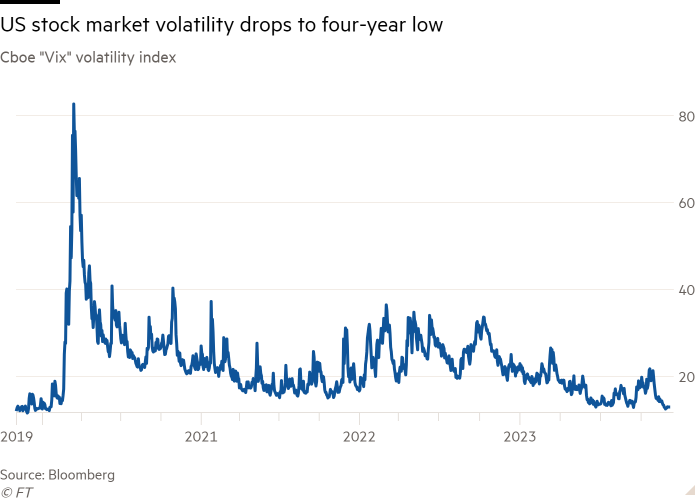Unlock the Editor’s Digest for free
Roula Khalaf, Editor of the FT, selects her favourite stories in this weekly newsletter.
A closely watched gauge of US stock market volatility has plunged close to a four-year low over the past month, sparking concerns that investors are growing complacent in betting that the Federal Reserve can tame inflation without causing an economic downturn.
The Vix — which measures the premiums investors are willing to pay to protect their portfolios against swings in the S&P 500 index and is popularly known as Wall Street’s “fear gauge” — fell to 12.4 this week, down from more than 20 in late October and its lowest level since November 2019. It ended this week slightly higher at 12.6.
The decline came as Wall Street’s benchmark index recorded its best month since July 2022, boosted by US inflation falling more than expected to 3.2 per cent in October, the first drop in four months.
The slowdown in inflation has left investors increasingly optimistic that the Federal Reserve will begin to cut interest rates in the first half of 2024. Crucially, the Fed has so far succeeded in bringing down price growth without triggering an economic downturn that would be painful for stocks.
“It feels like there is building confidence that the Fed can pull off a soft landing,” said Jim Tierney, head of US growth investments at AllianceBernstein.

Resilient consumer spending, solid corporate earnings in the third quarter and the containment of the war between Israel and Hamas had all contributed to investors’ newfound appetite for equities while helping to drive the Vix to its recent lows, he added.
Over the past five years, the Vix has only been at or below a reading of 12 on 25 trading days, of which five came in January 2022 at the start of last year’s bear market, according to DataTrek, a research group. Figures from exchange operator Cboe Global Markets show that trading volumes in options tied to the Vix are on course to hit a record this year.
Yet analysts warn that ostensibly tranquil markets have a habit of breeding instability as investors increase their equity positions and leverage.
Prices for longer-term options contracts reflect those concerns, according to Mike Zigmont, head of trading and research at Harvest Volatility Management. Markets expected the low volatility environment “to be only a near-term thing”, he said, with higher volatility forecast for next year and beyond.
Volatility has been “unusually low” so far in 2023 despite high interest rates, weakening economic data and elevated geopolitical tensions, said US equity and quantitative strategists at JPMorgan. The bank blamed the disconnect on a “longer than normal” lag between rates rising and economic growth slowing, as well as a surge in popularity of short-dated stock options, which are not captured by the main Vix index.
“The market is far from appreciating the known risks [surrounding] commercial real estate, rising bankruptcies and credit delinquencies, and unknown unknowns” stemming from the shift from 15 years of ultra-low interest rates, the JPMorgan analysts added.











